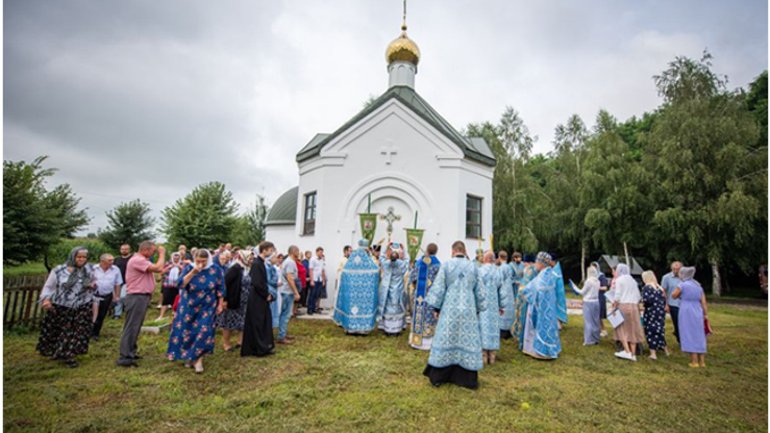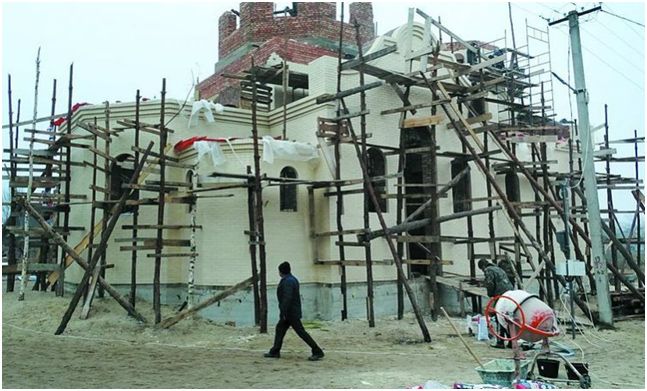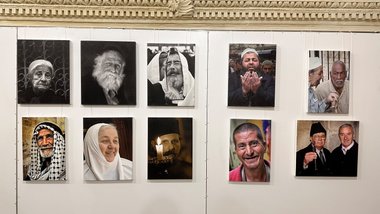From persecution to creeping expansion: UOC-MP goes on the offensive

Beginning last year, the official and “near-church” media of the Ukrainian Orthodox Church-Moscow Patriarchate (UOC-MP), began to flaunt the consecration of a new church. That church was built to replace "the one captured by the Orthodox Church of Ukraine (OCU) raiders." The spokesman for the UOC-MP, Metropolitan Kliment of Nizhyn and Pryluky (Vecherya), said the following at an interview with the Russian website “pravoslavie.ru”: "In those places, where our temples were taken away, in most cases, we have already built new ones." The construction sometimes occurred in a staggering speed, from 8 to 3 months. What could be the possible reason for the observed rapid reaction and what is likely to follow?
"Persecution" - a highly liquid product.
It is obvious, that the UOC-MP consistently fulfills the task of its command center, to preserve the church influence at any cost. The task for the UOC was set in 2014, after the start of the war with Russia. At that time, it was difficult to maintain the reputation of the UOC-MP, as there was enough information about a large number of clergy and some bishops, supporting the Russian invasion of Donbas as well as the support for the annexation of Crimea. The UOC-MP was saved from destruction, not surprisingly, by the then President Petro Poroshenko. More precisely, his unwillingness to create a powerful internal front against the background of the war.
In 2018 Patriarch Bartholomew bestowed autocephaly for the OCU communities. In the absence of canonical and legal objections, the technology of "persecution against the canonical church" was launched by UOC-MP. Various methods of demonstrating "persecution" were used, which gave the Moscow Patriarchate enough opportunities to discredit both the OCU and the Ukrainian authorities, including the international arena.
The culmination of the "persecution", were protests against the arrival of Patriarch Bartholomew in Kiev in August 2021. It was immediately clear, that the numerous processions and signatures against all evil, was not to protect the rights of believers. Today, the UOC-MP is moving from the tactics of the persecuted to the strategy of creeping expansion. The time has arrived for the scenario of receiving dividends from the opposing church for being "persecuted”. And so, after the rain, new UOC-MP temples began to appear, as evidence of the long-awaited victory over the "enemies of the canonical church."
How did all this take place?
The scale of the new construction of churches is impressive. And, instead of the lost wooden temples, the Moscow Patriarchate, in many cases, builds solid stone buildings. In villages, where there was only one temple, another appears. Where local authorities for years refused to provide land and building permit for the Moscow Patriarchate churches, will now have to resolve the conflict between two communities, the OCU and the UOC-MP. Since 2019, many places have been consecrated "for growth" of the UOC-MP, laying a stone for the future foundation or installing a cross, to construct a building at an opportune time.
And, if after all the showdowns and litigation, the community of the OCU is given the use of a state-owned church, the UOC-MP builds its own church, no matter how many believers will attend, as it happened in the village of Susval, Volodymyr-Volynskyi district in Volyn. When it became clear that the legal truth was not on the side of the Moscow Patriarchate, a new construction the UOC-MP began. The foundation was erected in less than a week and the walls in less than 3 weeks.
But sometimes the UOC-MP still faces the refusal of local authorities. Then construction begins on a private plot, which is allegedly kindly provided by the parishioners of the UOC-MP, or bought from third-party owners (fortunately, many houses with land are put up for sale).
No secret is made of such operations. For example, in the above-mentioned interview, Metropolitan Kliment (Vecherya) admits: “In one village of the Nizhyn district, our church life was very weak. One day no one came to our church for the Feast of the Throne. But after the OCU took away this temple, people seemed to be transformed. They bought a house, cleared the territory, rebuilt everything, equipped the church. And now several dozen people come to the services of the UOC church there. They have already become much more zealous in the faith." The metropolitan does not specify the village in question.

Photographs, from the consecrations of the new temples, show that solid temple buildings are still being built "right in the field." Consecrated on September 27, 2021, the church in the village of Kopytkovo, Zdolbuniv district, Rivne region, was built in his own garden, according to the abbot
A similar story is about a village of Rakiv Lis, Kamin-Kashyrskyi district, Volyn region. The community, that remained under the jurisdiction of the UOC-MP, has not been registered, but a new church is being built on the site, as a residential building. The village council asked the Lutsk Construction Inspectorate (LCI) for explanations on the legality of such construction. The response was, that "construction is legal, a house is being built there, the construction permit corresponds to the shape of the building." That is, the cult building is being built on the foundation of an old house. But in fact, the new building looks rather solid. The priest of the Moscow Patriarchate does not allow Office of the Technical Inventory (OTI) representatives to inspect the construction.

In the village of Holyadyn, Volyn region, a local woman donated a plot of land for construction. Interestingly, from the very beginning, the religious community in this village was not registered. Therefore, the land was not legally registered. However, the new community of the OCU submitted the completed documents and received the use of the temple, but is now faulted for its action. The UOC-MP community is still not registered there, but the construction of a stone church is in full swing.
There are more and more such cases. It is clear, that the parishioners themselves could not manage such a construction. with the funds raised on their own, all they could manage is a simple fence. However, sources of funding can be traced. In one case, it was directly reported, that the money for the construction was provided by Metropolitan Anthony of Boryspil and Brovary (Pakanych). This means, that one of the great patrons of the UOC-MP, Vadym Novynsky, or his other "colleagues in the faith", may have been involved in the construction. The format of this involvement (personal wallet, oligarchs or foreign patrons) requires additional investigation.
By the way. As you can see, from the photo, the number of believers at such events is disproportionately small, when compared to the size of the newly built church. There is an explanation for this, which can be found even in the reports of the UOC-MP. There are not enough members in the community, but "numerous pilgrims" are taken to the consecration of new churches (for the sake of the picture). There is no doubt, that the new churches will soon become places of pilgrimage for UOC-MP believers, and that miracles and healings will begin there.
Stick with two ends.
But there are several problems with the construction of a cult building on private land.
First, in order to build a temple, it is necessary secure a permit for the intended structure. When the temple is built in the abbot's garden, it is unlikely that such a permit was received.
Second, if the land remains privately owned, it is likely that the temple will be privately owned by the landlord. Consequently, the fate of the temple can be decided in the future by the owner or relatives of the property owner: sell, donate, include in the will, etc. Such transaction can be accomplished with residential real estate, not a temple.
Third, to insure against "temple raiding," the diocesan administration can buy back vacant plots, many of which are now up for sale. Consequently, the parish may lose its building.
Let's not forget about the provisions of the Land Code, according to which legal entities can acquire land ownership only for business activities. Religious organizations have the right of permanent possessing land for the construction of religious buildings. If the plot (especially for agricultural purposes, such as the abbot's garden) is purchased at the expense of the diocese, but it is registered as private property (for example, for the bishop of the diocese), the diocese may sooner or later file a lawsuit with the bishop or the abbot (if he is no longer a member of this Church), or even with his heirs, demanding that the land purchase agreement be declared invalid. With a high probability, individuals will lose ownership of the land to the heirs of the deceased bishop, by whom the land was purchased, as was the case with the Kolomyia-Chernivtsi Diocese of the Ukrainian Greek Catholic Church.
There is great doubt that the construction of new temples is legal. After all, the religious organization must first apply to the local authorities and ask for a separate plot of land for the church. After approval, a whole package of permits is collected, including land management and details of the religious building. Only after completing those requirements the construction work can begin. In the absence of such documentation, constructed temples will be considered unauthorized.
For example, the Church of the Transfiguration in the village of Yasinya (Plytovaty forest plot) Rakhiv district, Zakarpattia region, was built in 3 months. It is unknown how all permits were issued in such a short period, including for the supply of electricity. If the temple is located on a private land, then in fact utilities are assessed at residential rate.
In principle, local authorities have to monitor compliance with the law. But there is no truth or verification. Our government is afraid to return the activities of religious organizations to the legislative field. And it is this inaction, that gives rise to the "lynch courts", where citizens and individual organizations take matters to courts, which Russian propaganda likes to call "radicals."
Apparently, the Moscow Patriarchate is already working on the legal aspects of regaining control over the disputed property. On September 20, a meeting of representatives of the eparchial legal departments of the UOC-MP took place in the Kyiv-Pechersk Lavra. The mobilization of this legal army is not accidental. Obviously, we will face a new round of confrontation over the name, land, temple ownership and various rights and freedoms of believers. We will face new court cases, criminal proceedings against "enemies of the canonical church", provocations, pressure on the authorities and intimidation of believers by protests. As a result, an increase in "dividends" for "inconvenience caused" to former monopolists.
What's next?
Theoretically, there are many options. But we are interested in possible unforeseen events, of losing control over the religious situation in Ukraine. For example, when the restoration of the structural integrity of the UOC-MP is completed, the issue of blocking the so-called "Law on Renaming" will lose its relevance for the Moscow Patriarchate. After all, then the ROC will be able to triumphantly return to Ukraine in its original name, formally fulfilling the requirements of the law. As practice shows, many believers of the UOC-MP know, that they belong to the Moscow Patriarchate, but do not want additional stigmatization, because of such a "trifle" as a name.
This kills two hares. On the one hand, the ROC's reputation, as the main and effective squeaky wheel, in the eyes of the Kremlin, has retained its influence in Ukraine, that was almost lost by the Kremlin itself, is being restored. On the other hand, it is now possible to begin negotiations with the Kyiv metropolitanate on the gradual subordination of the newly built church property to the Moscow Patriarchate. After all, the Law on Freedom of Conscience speaks of the legal autonomy of a religious community, but there are no strict guidelines regarding the ownership of property. What prevents the eparchy of the ROC, as a non-resident legal entity, from acquiring cult property of the UOC-MP? Nothing. There are always legislative loopholes.
A bit of theory on hybrid wars.
The goal of any religious hybrid war is not to destroy the enemy, but to self-disorient and self-disorganize. Now, the most important issue for Ukraine is the preservation of the so-called dual identity, which significantly reduces immunity to external aggression (cultural, economic, spiritual, political, armed). But the matter is complicated, more than twofold, by the fact that with the help of religious structures, a distorted identity is formed. On the one hand, the believers of the UOC-MP really consider themselves Ukrainians, by the fact of living in Ukraine. On the other hand, church propaganda, of "being out of politics", the flock rejects the "rhetoric of war" with Russia, shifting attention to the internal enemy: "schismatics", "raiders" or "a scoundrel of the rotten West". The survival of a certain community of believers is higher than the survival of their country of residence.
What happens in the case of temple clashes, which the UOC-MP tries to present as a global religious conflict? The Russians, who are actively developing hybrid warfare technologies in the post-Soviet space, describe one of them as "point injections". With their help, the radicalization of certain groups of the population is achieved and the ability of the state authorities to keep the situation under control is discredited. Ironically, such methods are equated by the Russians themselves with terrorism. In a hybrid war, it is a hybrid terrorism that will not deal with weapons or hostage-taking.
Any "ceasefire" weakens group consolidation. But what if the Church is commanded to call for peace and understanding, but that will in fact destroy the consolidation of the flock? We need to look for other reasons for consolidation, and there are doubts that we will see a reduction in aggression.
Translated by Bohdan M. Slabyj










